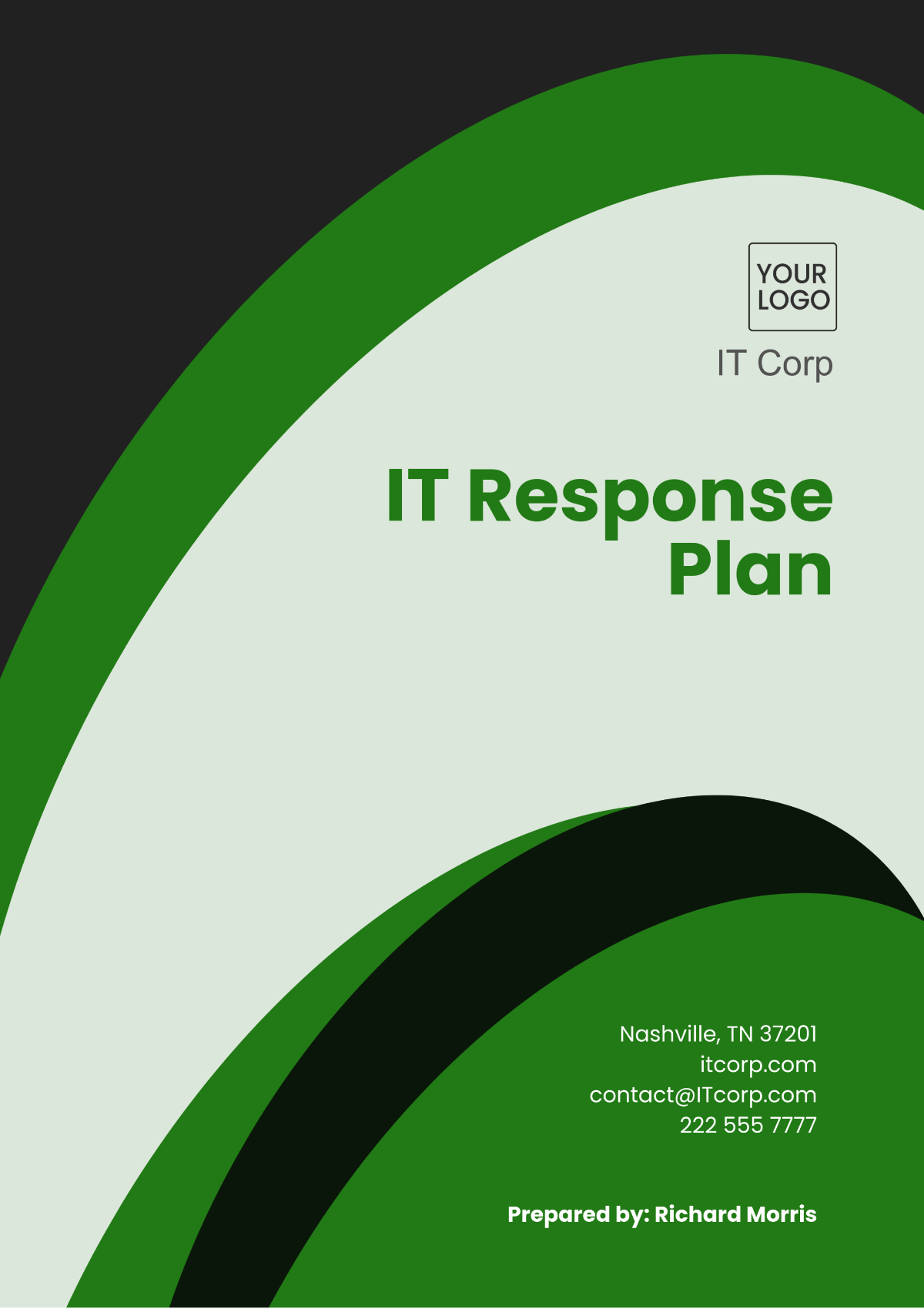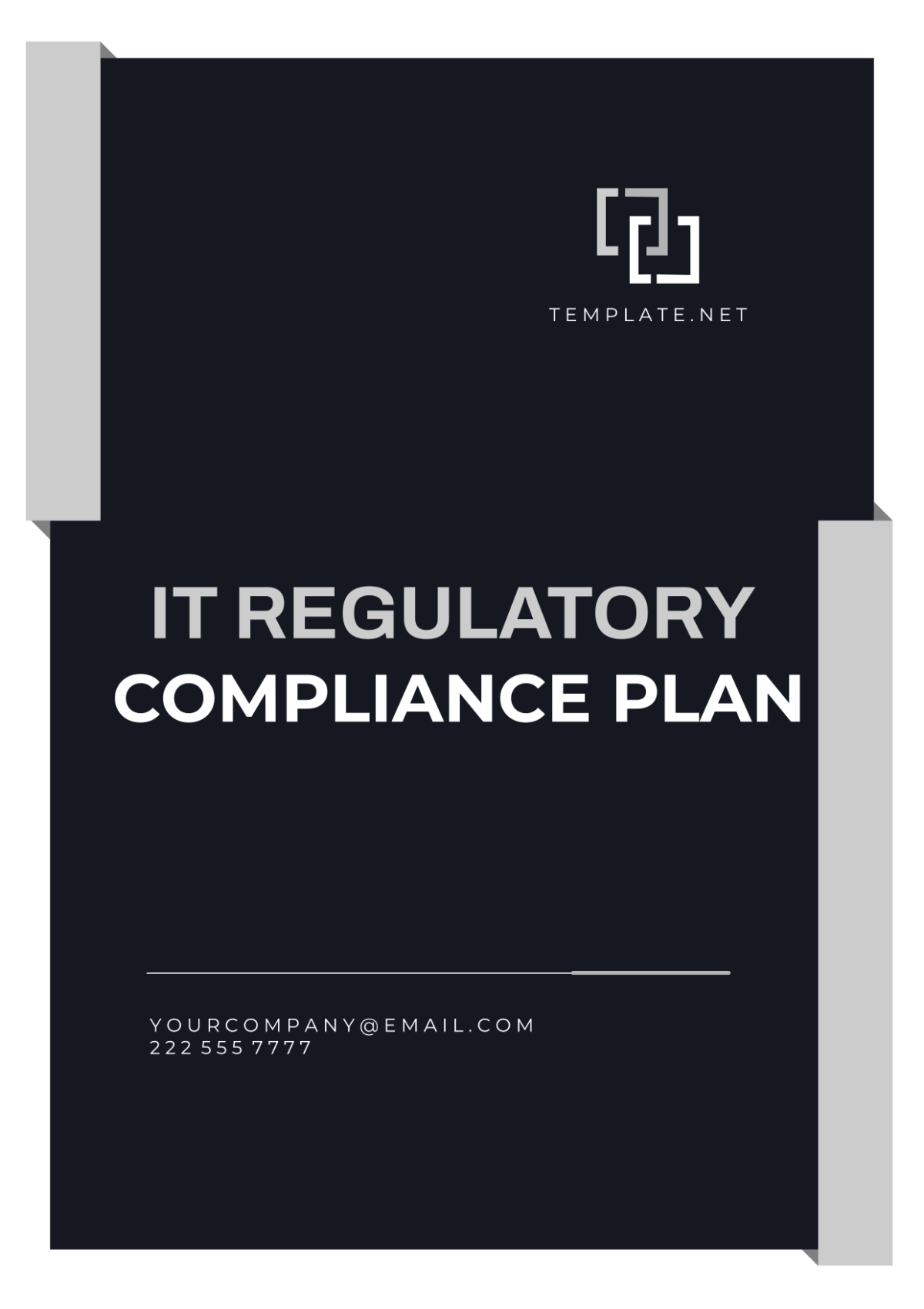IT Response Plan
1. Introduction
1.1 Purpose
The IT Response Plan of [Your Company Name] is a critical document designed to guide the organization through the process of responding to, managing, and recovering from IT-related incidents and disruptions. The purpose of this plan is to provide a structured approach to identifying, addressing, and resolving IT issues that could impact the company's operations. It aims to:
Ensure Prompt Response: Establish clear procedures for rapid identification and response to IT incidents.
Minimize Damage: Implement strategies to reduce the impact and prevent further damage to IT systems and data.
Facilitate Recovery: Outline steps for restoring normal operations and systems as quickly as possible.
Promote Communication: Ensure effective communication both internally within the organization and externally with stakeholders and regulatory bodies.
1.2 Scope
The IT Response Plan applies to all IT assets and resources within [Your Company Name]. This includes:
Hardware: Servers, workstations, networking devices, and peripherals.
Software: Operating systems, applications, and custom software.
Data: Databases, file systems, and cloud storage.
Networks: Internal networks, internet connections, and remote access solutions.
The plan covers various types of incidents, including but not limited to:
Cybersecurity Breaches: Unauthorized access, data theft, ransomware attacks.
System Failures: Hardware malfunctions, software crashes, network outages.
Data Breaches: Loss of sensitive information, data corruption, unauthorized data access.
Natural Disasters: Events such as earthquakes, floods, and storms that affect IT infrastructure.
Human Errors: Mistakes or negligence by employees or contractors that lead to IT incidents.
1.3 Objectives
The objectives of the IT Response Plan are to:
Define Clear Roles and Responsibilities: Specify who is responsible for managing various aspects of incident response.
Establish Incident Handling Procedures: Provide a detailed process for detecting, reporting, assessing, and responding to IT incidents.
Ensure Effective Communication: Facilitate timely and accurate communication with all relevant parties during an incident.
Support Business Continuity: Implement measures to minimize downtime and maintain essential business functions.
Achieve Compliance: Meet legal, regulatory, and industry requirements related to IT incident management.
2. Roles and Responsibilities
2.1 IT Response Team
The IT Response Team at [Your Company Name] is responsible for managing and coordinating all aspects of incident response. The team comprises the following key roles:
2.1.1 Chief Information Officer (CIO)
Responsibilities: The CIO provides overall leadership and oversight for the IT Response Team. They are responsible for making strategic decisions, allocating resources, and ensuring that the response aligns with organizational goals and priorities.
Duties:
Approve and endorse the incident response strategy.
Allocate necessary resources for incident management and recovery.
Communicate with senior executives and board members about the incident status and impact.
2.1.2 IT Security Manager
Responsibilities: The IT Security Manager focuses on managing cybersecurity incidents, leading investigations, and coordinating with external security experts and law enforcement when necessary.
Duties:
Implement and manage security measures to prevent and respond to cyber threats.
Conduct forensic analysis to determine the source and impact of security incidents.
Develop and update security policies and procedures.
2.1.3 IT Operations Manager
Responsibilities: The IT Operations Manager is responsible for maintaining the continuity of IT operations and managing technical aspects of incident response and recovery.
Duties:
Oversee the restoration of IT services and systems.
Coordinate with technical teams to address and resolve technical issues.
Document all incident-related activities and decisions.
2.1.4 Communications Manager
Responsibilities: The Communications Manager handles internal and external communications related to IT incidents, ensuring that accurate and timely information is provided to all stakeholders.
Duties:
Draft and distribute incident notifications and updates to employees, customers, and the media.
Manage media relations and handle inquiries related to the incident.
Coordinate with legal and compliance teams to ensure proper communication protocols are followed.
2.2 Incident Response Roles
2.2.1 Incident Coordinator
Responsibilities: The Incident Coordinator acts as the central point of contact during an incident, facilitating communication among team members and ensuring that response procedures are followed.
Duties:
Coordinate activities among IT Response Team members and other stakeholders.
Maintain a detailed incident log and track the status of response actions.
Ensure that all response activities are documented and reported accurately.
2.2.2 Technical Specialist
Responsibilities: Technical Specialists provide specialized expertise in diagnosing and resolving IT issues, working closely with other team members to address technical challenges.
Duties:
Analyze and troubleshoot technical problems to identify root causes.
Implement solutions and fixes to address issues and restore normal operations.
Collaborate with vendors and third-party experts as needed.
2.2.3 Compliance Officer
Responsibilities: The Compliance Officer ensures that all incident response activities comply with legal, regulatory, and contractual obligations.
Duties:
Review and ensure adherence to relevant laws, regulations, and industry standards.
Assist with incident reporting to regulatory bodies and other external entities.
Maintain documentation related to compliance and regulatory requirements.
3. Incident Detection and Reporting
3.1 Detection Mechanisms
3.1.1 Monitoring Tools
To detect potential IT incidents, [Your Company Name] utilizes a range of advanced monitoring tools, including:
Network Intrusion Detection Systems (NIDS): These systems monitor network traffic for signs of suspicious activity, such as unauthorized access attempts or data exfiltration.
Security Information and Event Management (SIEM): SIEM platforms collect and analyze security event data from various sources, providing real-time alerts and facilitating incident investigation.
Endpoint Detection and Response (EDR): EDR solutions monitor and protect end-user devices, detecting and responding to threats such as malware and ransomware.
These tools are configured to generate alerts based on predefined thresholds and patterns, allowing for early detection of potential incidents.
3.1.2 Incident Indicators
Key indicators of an IT incident that employees and IT staff should be aware of include:
Unusual System Performance: Reports of system slowness, unexpected errors, or crashes that deviate from normal behavior.
Unauthorized Access: Detection of unusual login attempts, failed access attempts, or unauthorized access to sensitive data.
Data Anomalies: Unexplained changes in data, such as unexpected deletions, modifications, or data corruption.
Early recognition of these indicators is crucial for prompt incident detection and response.
3.2 Reporting Procedures
3.2.1 Internal Reporting
Employees must promptly report suspected IT incidents using the following procedures:
Help Desk: Submit a ticket through the company’s help desk system, providing detailed information about the incident.
Email: Send an incident report to [IT Incident Reporting Email Address], including a description of the issue and any relevant evidence.
Phone: Contact the IT support hotline at [IT Support Phone Number] for urgent issues requiring immediate attention.
All incident reports should include essential details such as the time of occurrence, nature of the incident, affected systems, and initial observations.
3.2.2 External Reporting
For significant incidents that involve external parties or have broader implications, the following external reporting procedures should be followed:
Regulatory Bodies: Notify relevant authorities and regulatory bodies as required by law, providing details of the incident and any potential impact.
Third-Party Vendors: Inform vendors whose services or products are involved or affected, coordinating with them to address and resolve the incident.
Proper external reporting ensures compliance with regulatory requirements and facilitates collaboration with external partners.
4. Incident Assessment and Classification
4.1 Incident Assessment
4.1.1 Initial Assessment
Upon receipt of an incident report, the IT Response Team performs an initial assessment to:
Verify the Incident: Confirm that the reported issue is indeed an IT incident and not a false alarm.
Determine the Impact: Evaluate the potential impact on business operations, data, and systems.
Prioritize the Incident: Classify the incident based on its severity and urgency, guiding the response and resource allocation.
The initial assessment is critical for determining the appropriate response actions and prioritizing efforts.
4.1.2 Impact Analysis
Conduct a thorough analysis of the incident's potential impact, including:
Business Operations: Assess how the incident affects business processes, productivity, and service delivery.
Data Integrity: Determine whether data has been compromised, lost, or corrupted, and evaluate the implications for data recovery.
Compliance: Review the impact on regulatory compliance and contractual obligations, ensuring that any necessary reporting or notifications are made.
A comprehensive impact analysis helps in understanding the full scope of the incident and planning the appropriate response.
4.2 Incident Classification
4.2.1 Classification Criteria
Incidents are classified based on the following criteria:
Severity Level: Incidents are categorized as Low, Medium, High, or Critical based on their potential impact and urgency.
Impact Area: Identify the specific area affected by the incident, such as System, Network, Application, or Data.
Type: Classify the incident according to its nature, including Cybersecurity, System Failure, Data Breach, or Natural Disaster.
Effective classification helps in prioritizing response efforts and allocating resources appropriately.
4.2.2 Classification Examples
Low Severity: Minor performance issues that do not significantly impact business operations or data integrity.
High Severity: System outages that affect multiple departments and require immediate attention to restore normal operations.
Clear classification of incidents ensures that response efforts are focused on the most critical issues.
5. Incident Response Procedures
5.1 Containment
5.1.1 Short-Term Containment
Immediate actions are taken to limit the spread and impact of the incident, including:
Isolate Affected Systems: Disconnect compromised systems from the network to prevent further spread of the incident.
Disable User Accounts: Temporarily disable accounts involved in the incident to prevent unauthorized access and mitigate risks.
Short-term containment measures are crucial for stopping the immediate impact and preventing further damage.
5.1.2 Long-Term Containment
Plan and execute longer-term containment measures to address the incident more comprehensively:
Apply Patches: Implement security patches or fixes to address vulnerabilities and prevent recurrence.
Change Access Controls: Update permissions and access rights to restrict access and prevent further exploitation.
Long-term containment involves more strategic measures to address underlying issues and secure systems.
5.2 Eradication
5.2.1 Root Cause Analysis
Identify and analyze the root cause of the incident to prevent future occurrences:
Investigate Vulnerabilities: Examine weaknesses or flaws that were exploited during the incident.
Review Logs: Analyze system and network logs to gather evidence and understand the sequence of events.
Root cause analysis is essential for understanding the underlying issues and implementing effective remediation.
5.2.2 Remediation
Implement corrective actions to remove the root cause and restore normal operations:
Remove Malicious Software: Clean affected systems of malware or unauthorized software that contributed to the incident.
Strengthen Security: Enhance security measures, such as updating firewalls and intrusion detection systems, to prevent similar incidents.
Remediation efforts focus on resolving the immediate issues and strengthening security to prevent future incidents.
5.3 Recovery
5.3.1 System Restoration
Restore affected systems and services to their normal operational state:
Restore from Backups: Use backup copies to recover lost or corrupted data and ensure that systems are restored to a known good state.
Verify System Integrity: Test and verify that systems are functioning correctly and securely before bringing them back into full operation.
System restoration ensures that normal operations are resumed and that systems are secure and stable.
5.3.2 Post-Incident Review
Conduct a review of the incident and response efforts to evaluate performance and identify areas for improvement:
Analyze Response Effectiveness: Assess how effectively the incident was managed and whether response procedures were followed.
Update Procedures: Revise the IT Response Plan based on lessons learned from the incident to enhance future response efforts.
The post-incident review provides valuable insights for improving incident response and preparedness.
6. Communication
6.1 Internal Communication
6.1.1 Incident Notifications
Notify employees about the incident and its impact using the following methods:
Email Alerts: Send detailed notifications to employees, including information about the incident, actions being taken, and any required employee actions.
Intranet Updates: Post updates on the company intranet to keep employees informed about the status of the incident and recovery efforts.
Internal communication ensures that employees are aware of the incident and any actions they need to take.
6.1.2 Regular Updates
Provide regular updates to keep employees informed about the incident’s progress:
Status Reports: Share periodic updates on the status of the incident, recovery efforts, and any changes in the situation.
Post-Incident Briefings: Conduct briefings to review the incident, response actions, and lessons learned with relevant staff.
Regular updates help maintain transparency and keep employees informed throughout the incident.
6.2 External Communication
6.2.1 Customer Notifications
Inform customers if their data or services are affected by the incident:
Customer Emails: Send notifications to affected customers, providing details about the incident, its impact, and any actions being taken to address the situation.
Public Statements: Issue public statements or press releases to provide information about the incident and the company’s response, as needed.
Customer communication ensures that affected parties are informed and reassured about the company’s handling of the incident.
6.2.2 Regulatory Reporting
Report significant incidents to regulatory bodies in compliance with legal requirements:
Incident Reports: Submit detailed reports to regulatory bodies, including information about the incident, impact, and response actions.
Compliance Documentation: Provide evidence of compliance with regulatory requirements, including any required notifications or documentation.
Regulatory reporting ensures that the company meets legal obligations and maintains transparency with regulators.
7. Training and Awareness
7.1 Training Programs
7.1.1 Employee Training
Provide ongoing training to employees on IT incident reporting and security best practices:
Incident Reporting Procedures: Educate employees on how to recognize and report IT incidents, including the use of reporting tools and contact information.
Security Best Practices: Train employees on best practices for IT security, such as password management, phishing prevention, and safe handling of sensitive data.
Regular training helps employees stay informed and prepared to handle potential IT incidents.
7.1.2 Response Team Training
Ensure that the IT Response Team receives specialized training to effectively manage incidents:
Incident Management: Conduct drills and simulations to practice response procedures and improve coordination among team members.
Technical Skills: Provide advanced training in relevant technologies and tools to enhance the team’s technical capabilities.
Response team training ensures that members are well-prepared to handle incidents and execute response procedures effectively.
7.2 Awareness Campaigns
7.2.1 Internal Campaigns
Run internal awareness campaigns to promote IT security and response readiness:
Security Awareness: Increase awareness of security threats, prevention measures, and best practices among employees.
Response Readiness: Ensure that employees are familiar with their roles and responsibilities in the event of an IT incident.
Internal campaigns help reinforce security awareness and ensure that employees are prepared for potential incidents.
7.2.2 External Campaigns
Engage with external stakeholders to raise awareness of the company’s IT incident response capabilities:
Customer Communication: Share information with customers about the company’s incident response practices and how incidents are managed.
Vendor Collaboration: Coordinate with vendors to ensure they understand their roles in incident response and are prepared to support the company’s efforts.
External campaigns help build confidence among stakeholders and strengthen relationships with partners and customers.
8. Documentation and Reporting
8.1 Incident Documentation
8.1.1 Incident Logs
Maintain detailed logs of all incidents, including:
Incident Details: Document the nature of the incident, affected systems, impact, and response actions taken.
Timeline: Record key events and milestones during the incident, including detection, containment, and resolution efforts.
Incident logs provide a comprehensive record of the incident and response activities, which is valuable for analysis and reporting.
8.1.2 Evidence Collection
Collect and preserve evidence for investigation and compliance purposes:
Data Preservation: Secure copies of affected data, system logs, and other relevant information for analysis and recovery.
Forensic Analysis: Conduct forensic analysis to understand the cause and impact of the incident, and gather evidence for potential legal or regulatory actions.
Evidence collection is essential for understanding the incident and supporting investigations and compliance efforts.
8.2 Reporting Requirements
8.2.1 Internal Reports
Generate internal reports for management review and performance evaluation:
Management Review: Provide detailed reports to senior management, including information about the incident, response actions, and impact.
Performance Evaluation: Assess the effectiveness of the response and identify areas for improvement, including lessons learned and recommendations.
Internal reports help management understand the incident and response efforts, and support continuous improvement.
8.2.2 External Reports
Prepare external reports for regulatory compliance and public disclosure:
Regulatory Compliance: Submit required reports to regulatory bodies, including detailed information about the incident and response actions.
Public Disclosure: Issue public statements or press releases if necessary to maintain transparency and address public concerns.
External reports ensure compliance with legal requirements and maintain transparency with regulators and the public.
9. Plan Review and Maintenance
9.1 Plan Review
9.1.1 Regular Reviews
Review and update the IT Response Plan on a regular basis to ensure its effectiveness:
Annual Review: Conduct a comprehensive review of the plan each year to ensure it remains current and effective.
Post-Incident Review: Update the plan based on lessons learned from actual incidents to address any identified gaps or deficiencies.
Regular reviews help ensure that the plan remains relevant and effective in addressing emerging threats and changes in the IT environment.
9.1.2 Plan Testing
Conduct regular tests and exercises to validate the effectiveness of the plan:
Tabletop Exercises: Simulate incidents in a controlled environment to evaluate response procedures and coordination among team members.
Full-Scale Drills: Perform full-scale drills to test the entire response process, including communication, containment, and recovery activities.
Testing and exercises help identify areas for improvement and ensure that the plan is effective in real-world scenarios.
9.2 Plan Maintenance
9.2.1 Document Updates
Ensure that the IT Response Plan documentation is up-to-date:
Version Control: Maintain version control to track changes and updates to the plan, ensuring that the most current version is in use.
Distribution: Distribute updated copies of the plan to all relevant stakeholders, including IT staff, response team members, and external partners.
Document updates help ensure that all stakeholders have access to the latest information and procedures.
9.2.2 Continuous Improvement
Implement improvements to the IT Response Plan based on feedback and evolving threats:
Feedback: Collect feedback from response team members and other stakeholders to identify areas for improvement and address any issues.
Emerging Threats: Adapt the plan to address new and evolving threats, incorporating the latest best practices and technologies.
Continuous improvement helps ensure that the plan remains effective and relevant in the face of changing threats and business needs.




